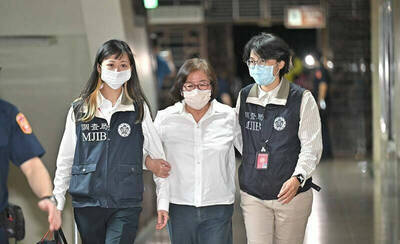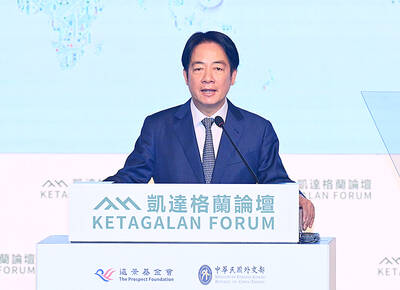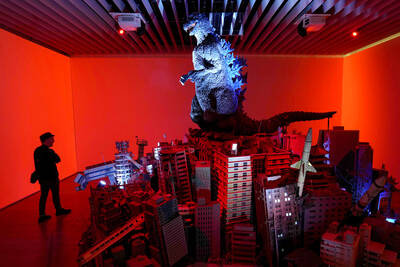There is a tone to Chinese official propaganda that is worthy of Professor Pangloss and his irrefutable case that “all is for the best in the best of all possible worlds.” Beijing’s favoured phrases, such as “win-win cooperation” and “community of common destiny for all mankind,” are designed to evoke an image of China as the fountainhead of conflict-free benevolence. A similar if much more sophisticated feeling runs through Keyu Jin’s (金刻羽) book.
Jin teaches economics at the London School of Economics. She is the Harvard-educated daughter of a former deputy minister of finance who now heads up China’s first multilateral development bank, the Asian Infrastructure Investment Bank. As such, she is well placed to compare key features of western and Chinese economic systems, as she does to good effect in this volume. She is perhaps less well placed — or less eager — to deal with politically contentious questions.
It is not that Jin ignores them. Rather, she displays a disconcerting lack of engagement and a tendency to omit unwelcome information. She acknowledges that there are issues that are likely to concern her readers, but also implies that they are rather beside the point. What matters for economists such as herself, she explains, are numbers and evidence. If either is lacking — on the question of recent events in Xinjiang, for instance — the topic cannot usefully be addressed.

This can produce a curious result. Jin’s book is cogently written, full of insights and rich in well-chosen anecdotes. But it also feels like a landscape peppered with concealed rabbit holes: the reader strolls happily across it, only to suddenly step into an empty space.
Take, for example, a reference to the many children who died in the Sichuan earthquake in 2008. The artist Ai Weiwei (艾未未), at the time not yet exiled from his homeland, was beaten up when he went to investigate and later mounted a moving exhibition of children’s backpacks. Jin’s reference to the child deaths occurs in a passage on the tendency of Chinese households to save.
She argues that when Chinese families were large, older generations felt less need to save because their children would take care of them in old age; with the one child policy, couples saved more. So far, so logical. Then she adds that “greater risks and uncertainty also provide incentives to save,” citing the earthquake deaths of the Sichuan children “in flimsily built schools.” The message seems to be that it is prudent to save harder because your only child might die and not be around in your old age.
Not mentioned is the corruption that built flimsy schools: tellingly, the party headquarters did not collapse. When the bereaved parents demanded accountability for their dead children, they were brutally suppressed.
Elsewhere, Jin refers to a drop in grain production between 1959 and 1961, without mentioning that harvests collapsed because of government policy, and between 30 and 50 million citizens starved to death as a direct result. This omission is the more surprising since she insists that accountability is the key to the legitimacy that she argues the Chinese Communist party enjoys. The real cause of that mass starvation is still not officially acknowledged.
The author also praises China’s COVID policies, which, she writes, were readily accepted — even embraced — by the population, despite ample evidence of protests in Shanghai and other areas against the many abuses of the system. Within three weeks of the first appearance of COVID-19 in Wuhan, she writes, the government had moved swiftly and effectively to protect the population. That is an assertion that might surprise the many scientists and WHO officials who have been unable to verify with certainty either the date or place of the first cases because of destroyed records and official obstruction. Even more recently, the spike in deaths that followed the abrupt reversal of the policy in December last year is being scrubbed from the record.
We learn that Chinese social media carries lively discussions on many topics that, she believes, would surprise western critics of China who take too narrow a view of life under the CCP. No doubt many westerners do lack subtlety and nuance in their perceptions of the country, but the study she cites in evidence was carried out between 2009 and 2013, a time of far greater freedoms and livelier debate on all fronts than exists under current conditions.
Today, according to China Digital Times, which tracks Chinese censorship, previously tolerated topics are censored.
“Financial news, once considered a relatively safe topic for public discussion, has been repeatedly censored amid a potential recession. Youth unemployment figures have been sporadically censored… Other recent targets of censorship include cremation statistics (which hint at COVID’s true death toll), reports on [the Chinese crime of] ‘picking quarrels and provoking trouble,’ health and science blogs, and even Alibaba listings of toys that were a tongue-in-cheek reference to a recent instance of official mendacity.”
As an economist, Jin is aware of the current debate between analysts who argue that China has peaked and may stagnate, and those who take a more optimistic view. Both agree that the era of rapid growth is over and the middle-income trap is threatened. They differ in their assessment of the system’s capacity to deal with it.
Jin is an optimist: while she acknowledges the well-rehearsed challenges — a ropey financial sector, huge internal debt, collapsing property market and an ageing population — she believes Beijing has a unique and still evolving model that will allow China to grow through these difficulties. In her account of the previous phases of Chinese growth she rightly points to the role of ambitious local politicians in fostering new companies and industries. Whether she is right to extrapolate from that experience that today’s leaders can address the country’s contemporary issues in the same pragmatic, incremental and ultimately successful manner, remains contested. Those who disagree point to endemic corruption, increased repression and stalled total factor productivity as obstacles yet to be effectively tackled.

Following the shock complete failure of all the recall votes against Chinese Nationalist Party (KMT) lawmakers on July 26, pan-blue supporters and the Chinese Communist Party (CCP) were giddy with victory. A notable exception was KMT Chairman Eric Chu (朱立倫), who knew better. At a press conference on July 29, he bowed deeply in gratitude to the voters and said the recalls were “not about which party won or lost, but were a great victory for the Taiwanese voters.” The entire recall process was a disaster for both the KMT and the Democratic Progressive Party (DPP). The only bright spot for

As last month dawned, the Democratic Progressive Party (DPP) was in a good position. The recall campaigns had strong momentum, polling showed many Chinese Nationalist Party (KMT) lawmakers at risk of recall and even the KMT was bracing for losing seats while facing a tsunami of voter fraud investigations. Polling pointed to some of the recalls being a lock for victory. Though in most districts the majority was against recalling their lawmaker, among voters “definitely” planning to vote, there were double-digit margins in favor of recall in at least five districts, with three districts near or above 20 percent in

From Godzilla’s fiery atomic breath to post-apocalyptic anime and harrowing depictions of radiation sickness, the influence of the nuclear bombings of Hiroshima and Nagasaki runs deep in Japanese popular culture. In the 80 years since the World War II attacks, stories of destruction and mutation have been fused with fears around natural disasters and, more recently, the Fukushima crisis. Classic manga and anime series Astro Boy is called “Mighty Atom” in Japanese, while city-leveling explosions loom large in other titles such as Akira, Neon Genesis Evangelion and Attack on Titan. “Living through tremendous pain” and overcoming trauma is a recurrent theme in Japan’s

The great number of islands that make up the Penghu archipelago make it a fascinating place to come back and explore again and again. On your next trip to Penghu, why not get off the beaten path and explore a lesser-traveled outlying island? Jibei Island (吉貝嶼) in Baisha Township (白沙鄉) is a popular destination for its long white sand beach and water activities. However, three other permanently inhabited islands in the township put a unique spin on the traditional Penghu charm, making them great destinations for the curious tourist: Yuanbeiyu (員貝嶼), Niaoyu (鳥嶼) and Dacangyu (大倉嶼). YUANBEIYU Citou Wharf (岐頭碼頭) connects the mainland